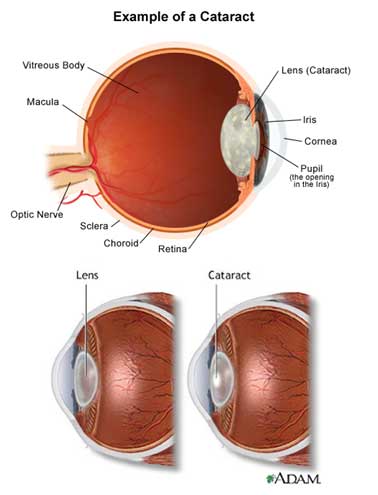|

When the eye’s naturally clear lens becomes clouded, it’s called a cataract. Most cataracts are the result of the natural process of aging. Others may be present at birth or develop as a result of physical, drug, or chemical injury. Cataract surgery, one of the most common operations performed in the U.S., clears up the cloudiness.

What Happens During Cataract Surgery?

During cataract surgery, the cloudy lens is removed or cleaned out and replaced by a clear manmade lens.
Most cataract surgeries are done with a technique called phacoemulsification (FAY-co-ee-mul-sih-fih-CAY-shun), also called "small cut (incision) cataract surgery." The cut (incision) can be smaller, because the harder center section of the lens is liquefied and then vacuumed out.
Under local anesthesia, a surgeon performing phacoemulsification makes a small opening on the side of your cornea. A device that sends out ultrasound vibrations is inserted into the eye and breaks the lens into small pieces. The fragments are then removed by suction through the small cut in the eye.

Your eye doctor may use a laser to make the cut. The hope is that a more precise cut will further improve recovery from cataract surgery.
After the cataract is removed, the surgeon usually replaces it with a new, man-made lens called an intraocular lens or IOL. This procedure is called "intraocular lens implantation."
The IOL is clear plastic, acrylic, or silicone with an optical power chosen by the surgeon to help restore normal vision, oftentimes minimizing the dependence on eyeglasses after surgery. This lens is permanent and needs no special care.

The IOL focuses light onto the retina to help improve your vision. Still, even if your natural lens is replaced with an intraocular lens, you probably will need a new eyeglass prescription. However, most people can see fairly well at a distance without glasses after modern cataract surgery with a cataract lens replacement.
Cataract surgery is done as an outpatient procedure in an operating room, so you don't have to stay in the hospital. The actual surgery usually lasts less than an hour. It is safe and in many ways desirable to be awake with some level of sedation during the surgery. A sedative is given and numbing drops are placed on the eyes. Another option is to use a novacaine injection placed around your eye. General anesthesia (breathing tube and fully asleep) is rarely used with cataract surgery. Talk to your surgeon about your options.
Doctors usually won't remove cataracts in both eyes at the same time. If you need both eyes done, you will be scheduled for separate surgeries, usually a few weeks apart.
|
